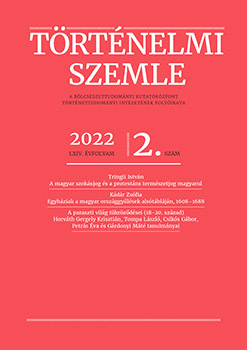A magyarországi jobbágyfelszabadítás végrehajtása és történészi percepciói
The Execution of the Hungarian Abolition of Peasant Serfdom and its Historiographical Perceptions
Author(s): Gergely Krisztián HorváthSubject(s): 19th Century
Published by: Magyar Tudományos Akadémia Bölcsészettudományi Kutatóközpont Történettudományi Intézet
Keywords: historical narrative; abolition of peasant serfdom; quantification; local research; social history
Summary/Abstract: The first part of the paper surveys the historiographical discourses about the abolition of peasant serfdom. While the examination of the abolition of serfdom in a local context only started in the early 1960s, the preceding decades had been dominated by three influential narratives. From the 1890s to the 1930s the historical syntheses argued that the great losers of the abolition were the former lords, while the winners were the former serfs. From the mid-1930s a more balanced judgement emerged, in which both parties were thought to have suffered the consequences of the dissolution of the old order and the market transition. After 1945, parallel to the sovietisation of Hungary, the exclusive dominance of historical materialism meant that, from the perspective of the peasantry, the balance of the abolition of serfdom became clearly negative. The quantitative analyses of the 1960s gradually nuanced the picture, and, as a result, by the 1980s the balanced judgement of the 1930s had been basically justified. The second part of the paper attempts to organise the evidence of the quantitative analyses into a database. The result, however, is that while the 52 researches that could be involved in the analysis contain information about more than 2200 settlements, only a tiny fragment of these are detailed enough to be of any help in reconstructing the balance of the abolition of serfdom on a national level: how much arable, pasture and meadow remained in the hands of the former serfs, and how much they lost. Accordingly, the author proposes a new, regionally and socio-historically representative research in order to answer the question.
Journal: Történelmi Szemle
- Issue Year: 2022
- Issue No: 2
- Page Range: 251-267
- Page Count: 17
- Language: Hungarian

